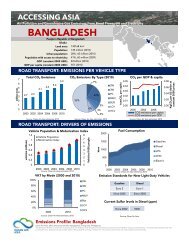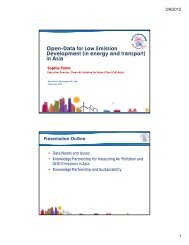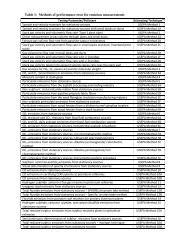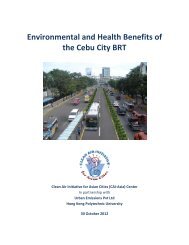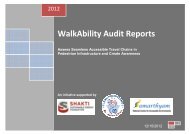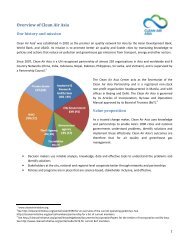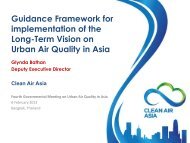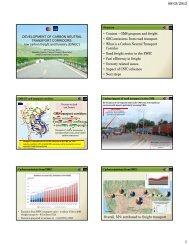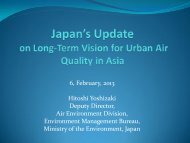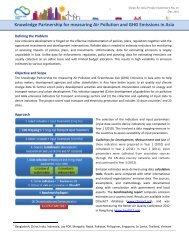International Experience and Best Practices - Clean Air Initiative
International Experience and Best Practices - Clean Air Initiative
International Experience and Best Practices - Clean Air Initiative
Create successful ePaper yourself
Turn your PDF publications into a flip-book with our unique Google optimized e-Paper software.
prudent judgment on what level of st<strong>and</strong>ards will comm<strong>and</strong> political support. 140 The<br />
pollutants covered will vary for gas vs. diesel engines (CO/HC/NOx vs. PM/smoke/<br />
NOx). A very tough st<strong>and</strong>ard that many vehicles flunk could erode support, as could<br />
a very easy st<strong>and</strong>ard that made the I/M program appear ineffectual. When phasing-in<br />
st<strong>and</strong>ards, policymakers should set st<strong>and</strong>ards or “cut-points” be set so that 15 to 20<br />
percent of vehicles fail. 141 However, this rate could be higher or lower depending on<br />
technical <strong>and</strong> cost factors. A consultant study for Sri Lanka provides a good example of<br />
how analysis <strong>and</strong> judgment can inform the recommendation of a set of st<strong>and</strong>ards (see<br />
Box 3-5).<br />
As emission st<strong>and</strong>ards for new vehicles are tightened, policymakers should set I/M<br />
st<strong>and</strong>ards for these vehicles that are appropriately stringent, reflecting newer technology<br />
<strong>and</strong> improved emissions performance. Older vehicles emit more due to the nature of<br />
their technology, as well as the inevitable deterioration of age. While this should lead to<br />
relatively lenient st<strong>and</strong>ards for older vehicles, at the same time, policymakers may want<br />
to set a relatively tough st<strong>and</strong>ard for older high-emitting vehicles in order to create some<br />
pressure for retiring the vehicle rather than maintaining it. 142<br />
54<br />
BOX 3-4. HEAVY-DUTY DIESEL I/M PROGRAMS IN THE U.S.<br />
Heavy-duty diesel vehicle emission inspection programs have been initiated in a number of<br />
locations in the U.S. in the last decade in an effort to identify, test <strong>and</strong> repair vehicles that<br />
emit excessive smoke. The earliest of these programs dates back to 1974 for the Arizona<br />
program, but most programs were initiated in the mid to late 1990s. At present, there are 16<br />
programs in operation in the U.S., <strong>and</strong> two in Canada. All of the 18 programs in operation<br />
as of March 2004 measure smoke opacity only as a surrogate for diesel emissions, but<br />
program structures <strong>and</strong> test methods vary across states.<br />
At present, there are three specific types of programs used:<br />
• Roadside Inspections: A sample of all trucks is selected at varied locations for<br />
smoke opacity testing.<br />
• Periodic Inspections: Trucks registered in a specific area are inspected annually or<br />
biennially at an inspection facility.<br />
• Self-Certification Program: This program is for fleets, which are allowed to conduct<br />
periodic tests in their own maintenance facility <strong>and</strong> report the results to the state.<br />
Most states use a test approved by the Society of Automotive Engineers for identifying a<br />
diesel vehicle's smoke emissions, called the SAE J1667 "snap-acceleration" test, with pass/<br />
fail st<strong>and</strong>ards of 55 percent smoke opacity for pre-1991 vehicles <strong>and</strong> 40 percent for 1991<br />
<strong>and</strong> later vehicles.” (Author’s note: some states add a third category of pre-1974 or pre-1976<br />
trucks with a 70 percent opacity st<strong>and</strong>ard)<br />
Source: Diesel Technology Forum, Smoke Testing Programs<br />
140 Faiz, A. et al, op. cit., pp. 141-144. Asian Development Bank, 2003, op. cit., p. 13-14. Weaver, C. <strong>and</strong> L.<br />
Chan, op. cit., p. 41-42. One reviewer argued that current EU I/M st<strong>and</strong>ards represent “internationally<br />
recognized” cut-points, but this was a lone viewpoint.<br />
141 Asian Development Bank, 2003, op. cit., p. 14.<br />
142 One reviewer argued strongly that technology alone should determine cut-points, <strong>and</strong> that age should<br />
not be a factor.



